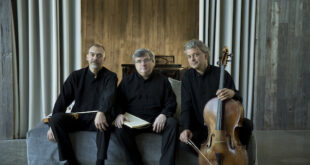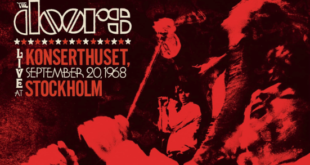Distressing news from a faraway place naturally makes one’s imagination color the place with the bad tidings. So given the geopolitical tension and saber-rattling surrounding Taiwan, the chance I got last September to speak with Jun Märkl, the Taiwan Philharmonic’s recently appointed music director, was a good reminder for me of the positive, creative side of life – and that life in general goes on mostly as usual for most people in most places most of the time.
On Friday in New York City, musicians from the Taiwan Philharmonic (known at home as the National Symphony Orchestra) reinforced that lesson with a chamber music concert in collaboration with the Chamber Music Society of Lincoln Center (CMS). Their renditions of music by Beethoven, Mozart, André Caplet, and a young Shostakovich helped show the vitality of the classical music scene in Taiwan – and assert the persistent power of artistic brotherhood across nations.

Co-artistic directors Wu Han (piano) and David Finckel (cello) sometimes appear at CMS concerts as MCs. It was nice to see them at their instruments this time, for a smashing performance of Beethoven’s Trio in E flat Major, Op. 1 No. 1. They were joined by violinist Chih-Hong Tseng, who is currently a candidate for concertmaster of the Taiwan Philharmonic.
Beethoven’s Very First Opus
This four-movement early work of Beethoven was a wonderful showcase for Wu Han’s dextrous, flowing pianism in particular. The musicians vitally expressed both its joy and its substance.
After a vigorous, stately first movement and a gently dynamic Allegro, the Scherzo took flight on the pianist’s dancing grace notes. The final movement’s rich, even dark harmonies developed organically from the delicate, exposed piano figures. Impeccable integration and musicianship made the whole work sing.
The Harp Tolls for Thee
Two modern works (i.e. from the early 20th century) varied the program substantially.
André Caplet wrote “Conte Fantastique” first for harp and orchestra, then for harp and string quartet, inspired by Poe’s story “The Masque of the Red Death.” It’s always fun to watch a harpist play; Shannon Shuen Chieh, harpist from the Taiwan Philharmonic, expressed her superb technique almost choreographically in a way that complemented the music’s programmatic – what today we’d call cinematic – nature.

I had not been familiar with Caplet or his work. The piece is wild and weird, fanciful, restless, recapitulating but not resolving, with dissonant elements. A banging on the wood beam of the harp indicated Death’s knock; the harp also simulated a tolling bell. It was all very dramatic, though the music wandered for a while before it got to that eerie release; I wasn’t sure there’d be a payoff. When it came it brought the whole thing to a satisfying, if grim, climax.
Matching Chieh in energy and skill was a mixed string quartet with members of the Taiwan Philharmonic and the CMS, playing as if they’d worked together for years.
The Precocious Shostakovich
Dmitri Shostakovich wrote his ambitious Prelude and Scherzo for String Octet, Op. 11 when still a student. But it’s a deep piece of work. This performance brought together two string quartets, one comprised of Taiwan Philharmonic musicians, the other of CMS artists. The musicians sat in a single curved row, producing interesting stereo panning effects.
The mournful Prelude has a vivid, sad energy. It received a full-tilt performance from start to ghostly finish. The startling Scherzo sounds urgent. As one, the musicians dug in to the composer’s brash experiments. The cello slid. A viola surged from the mix with a pizzicato solo. It was a performance that made one sit up and listen.
Mozart and the Clarinet
Mozart’s beautiful Quintet for Clarinet, Two Violins, Viola, and Cello in A major is a favorite of mine and a pinnacle of classical chamber music. Joined by another mixed string quartet, Taiwan Philharmonic clarinetist Julien Chun-Yen Lai played with dynamic phrasing, subtly varied timbre, charisma and conviction; I imagine Mozart, who was quite enamored of the clarinet, would have been pleased.
Overall, though, the performance was not up to the level of the rest of the program. The dynamics felt a little flat, the timing not always altogether precise, the intonation among the strings a touch off.
The lyrical second movement came off the best, with the clarinet taking the lead. But in the finale, as earlier, it didn’t seem the musicians were savoring the gorgeous music as one would expect; excellent work from Lai and the first violinist didn’t save the overall performance from a generally perfunctory aura.
Over the evening as a whole, though, it was a treat to experience this collaboration among artists representing the cream of the Taiwanese classical music scene and the uppermost tier of U.S. chamber music. Besides the superb skill on display and the great and varied music, one could feel the sturdiness of the cultural ties that unite the world through music and art, spanning oceans of distance – and forging through a steady flow of bad news.
As for good news: The full Taiwan Philharmonic performs a program including Bruch, Mendelssohn, Debussy, and Taiwanese composer Ke-Chia Chen, at the Kennedy Center this Wednesday, April 19; at Lincoln Center on the 21st; and in Chicago on the 23rd.
 Blogcritics The critical lens on today's culture & entertainment
Blogcritics The critical lens on today's culture & entertainment




